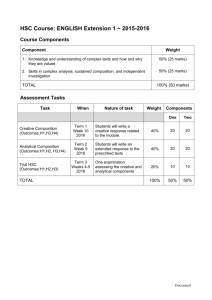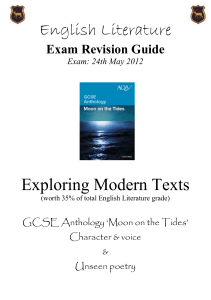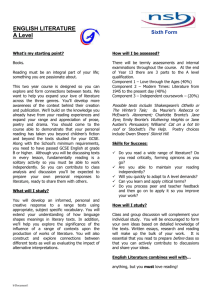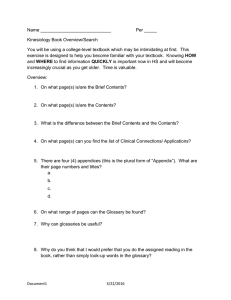Click here to view the transition pack.
advertisement
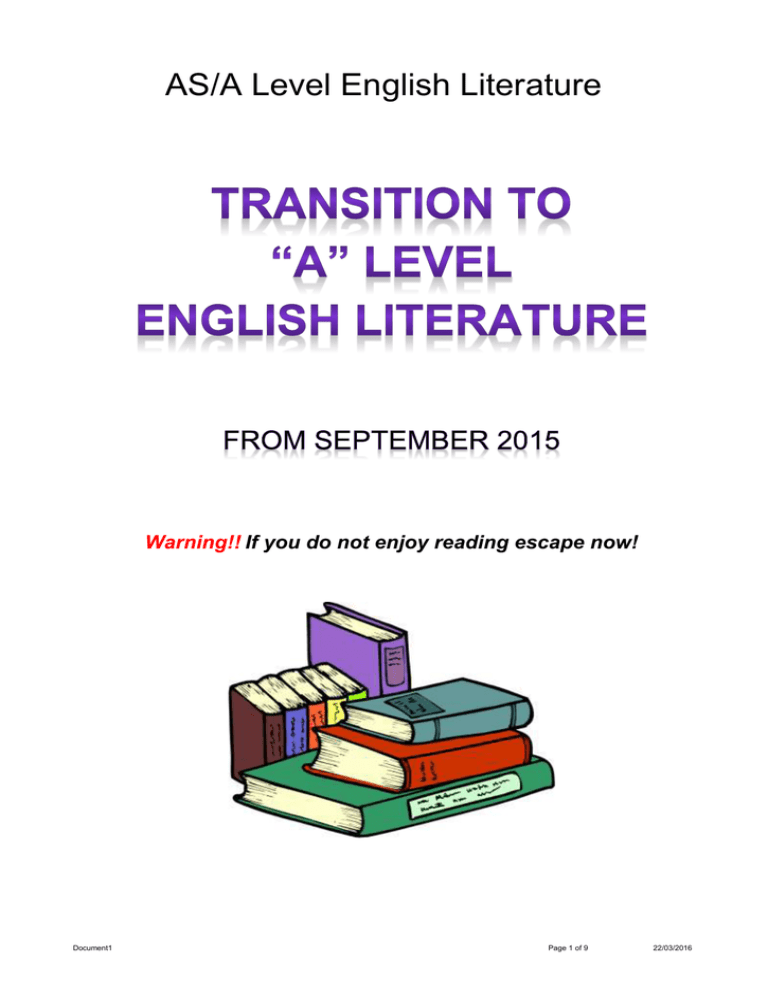
AS/A Level English Literature Warning!! If you do not enjoy reading escape now! Document1 Page 1 of 9 22/03/2016 Welcome to the “A” Level English Literature course English Literature “A” Level is designed to encourage students to explore the relationships that exist between texts and the contexts within which they are written, received and understood. “Studying texts within a shared context enables students to investigate and connect them, drawing out patterns of similarity and difference using a variety of reading strategies and perspectives.” English Literature at this level encourages students to actively read texts, engage in the process of autonomous meaning and to debate and challenge the interpretations of other readers as they develop their own informed personal responses. The specification encourages the exploration of texts in a number of different ways: the study of a literary theme over time the study of literature through engaging with two of the main historicist perspectives, the diachronic (reading texts written across widely different time periods that explore the same theme) and the synchronic (reading texts written within a narrower and clearly defined time period) the study of various texts, both singularly and comparatively, chosen from a list of core set texts and a list of chosen comparative texts. All texts, with the exception of the Wider Reading texts will be centre-chosen. writing about texts in a number of different ways. Throughout the course students will be expected, and required, to read widely across a range of texts and connect them across time and topic. Working with texts over time involves looking at ways in which authors shape meanings within their texts, and how this may be influenced by contextual thinking. It is important to recognise that texts and their meanings are not fixed, interpretation is not fixed, and multiple interpretations are possible. Second Warning!! Document1 If you do not enjoy reading you must escape now! Page 2 of 9 22/03/2016 The Transition from Year 11 to Year 12: from GCSE to “A” Level All Lady Lumley’s School students sit two GCSEs in English: English Language and English Literature. You should now be familiar with the differences between the two. At “A” Level we split the two and you can choose to study either English Literature or English Language or, if the option blocks allow, you can choose both. The English Literature course is designed to consolidate the skills you have learned during your GCSE course. At GCSE you studied all three genres: poetry, prose and drama, both pre and post 1900. At “A” Level you will study all three genres: poetry, prose and drama, across a period of time, and YES, this does include a Shakespeare text! The requirement is that you will study a minimum of eight texts across the genres. Further details of the specific texts will be available in September although a possible reading list is included in this booklet. Because of the changing nature of academic assessment in this country your assessments will be examination based. At AS Level 100% of the course is examined through a terminal exam At A Level 80% of the course is examined through a terminal exam and 20% is assessed through a compulsory NEA (Non Examined Assessment) Again further details will be available in September, although any queries should be addressed to Mrs C Farrell i/c KS5 English. Document1 Page 3 of 9 22/03/2016 Preparing for Year 12 and 13 The transition from studying English Literature at GCSE to studying English Literature at A Level is significant and although the A Level course is designed to develop skills already acquired at GCSE, the assessment of those skills is more specific and at a much higher level. In order to prepare you for the Year 12 AS English Literature course you need to: enjoy reading recognise that you are going to have to work hard be capable of working independently be willing to develop and express informed opinions be able to sit and focus upon a task for prolonged periods of time as well as meeting the important generic rules of: attending all lessons working co-operatively with staff and peer group meeting deadlines If you foresee any issues regarding these requirements you must speak to Mrs C Farrell or Mrs J Bartlett during the enrolment day. This course is designed to be a challenge and although a love of reading is an essential prerequisite it is only one factor on the road to success. Document1 Page 4 of 9 22/03/2016 Tasks for Summer 2015 It is important that during the summer break between Year 11 and Year 12 you maintain the work ethic developed during the exam season (as well as enjoy a relaxing holiday). By the time you return in the summer you need to have: Produce a one side of A4 review of your favourite book from childhood and your current favourite book. This does NOT have to be a comparison. Learn the attached A Level Literary Terms – you will be tested on them! Read the poem “La Belle Dame sans Merci” – (you will need to download a copy from the internet) Write a critical review of the poem (approximately two sides of A4). Do NOT just copy and paste! See next pages for A Level Literary Terms Document1 Page 5 of 9 22/03/2016 A level Literary Terms Aesthetic: Concerned with the appreciation of beauty. Allegory: Narrative description of a subject under guise of another suggestively familiar. Alliteration: Two or more words that begin with the same letter. The purpose is to stress or to draw attention to the meaning/line, e.g. The waxen woman slumped wearily to her knees. Allusion: Indirect reference (to mythology, history etc). Anachronism: The placing of something in the wrong historical setting. Antithesis: Contrasting ideas placed close together to give effect of balance. Assonance: The repetition of vowel sounds in the same line or closely adjacent lines of poetry, e.g. life like, moaning and groaning. Blank verse: Verse which does not rhyme. Bathos: The production of humour by a sudden change from the sublime to the ridiculous. Burlesque: An imitation of either a serious literary composition or the ideas of a group of people with the purpose of making them look ridiculous. Caesura: The brief pause in a line of poetry. Caricature: A type of character, usually exaggerated, easily recognisable. Catharsis: Outlet to emotion afforded by drama. Cliché: An overworked word or expression. Climax: The most convincing part of the argument; the part of a poem where the emotional pressure is the greatest. Couplet: Two consecutive lines of verse which rhyme and usually have the same metre. Criticism: The evaluation of a piece of literature not necessarily finding fault. Denouement: unravelling of plot: final solution to text. Diction: The choice of words a poet makes to create a certain effect. Didactic: Literature aimed at giving advice. Enjambment: When the sense/sentence carries over a line. Dirge: A burial song / public lament. - Dissonance: Harsh sounding words often chosen to create an effect Document1 Page 6 of 9 22/03/2016 Dramatic irony: a chance remark early in the text which foreshadows later events of great importance. Dramatic monologue: A poem in which the speaker is not the author but a character in the poem Elegy: As the above but more personal. Elision: Omission of syllable to aid metre, e.g. fall’n Epic: A long narrative poem dealing with matters of importance: destruction of Troy or Creation Epigram: Short, clever, witty or humorous saying Epigrammatic: A witty turn of thought, often satirical Euphemism: Using a more pleasant form of words Evocation: Language which calls up memories, images, feelings etc Soliloquy: A speech made to oneself in which characters usually reveal their innermost feelings to the reader/audience. Fable: Moral tale/poem often using animals to represent people. Farce: Drama with comic action of the most ridiculous kind. Figurative: Using many figures of speech; flowery, ornate. Free verse: Poetical writing with no regular scansion and irregular lines to give force of rhythm. Foregrounding: Emphasis through isolating a word or phrase. Genre: Type or style of writing: play/poem or Romantics/Elizabethans. Grandiloquent: marked by a lofty style Hyperbole: Intentional exaggeration in order to emphasise a point “A hundred years should go to praise Thine eyes, and on thy forehead gaze”. (Marvell) Iambic: Unstressed followed by stressed line of poetry. Imagery: Comparison between 2 or more usually unrelated objects or idea to clarify or add feeling. E.g. “Sleep that knits up the ravelled sleeve of care”. (Shakespeare) Irony: The opposite of what is meant or different to what is meant in order to make the real meaning more emphatic. (Dramatic irony: a chance remark early in the text which foreshadows later events of great importance). Lyric: Originally a song to a lyre: short, generally personal poem of feeling. Malapropism: Ludicrous misuse of words: mistaking a word for one resembling it. Melodrama: Sensational drama, tragic in its intention but comic in its bathos. Metaphor: A comparison in which two unconnected things are drawn together. “The man was a lion in battle”. Metre: Type and feet in verse line. Mock Heroic: Writing about trivialities but using a very high-flown. Style, e.g. Pope’s “Rape of the Lock” Document1 Page 7 of 9 22/03/2016 Mood: The overall emotional effect or feeling of the text. Motif: A particular idea or symbol recurring through text. Narrative verse: Verse that tells a story; ‘The Canterbury Tales” Nemesis: Greek goddess of retribution: wrong brings its own punishment. Neologism: Newly coined word or phrase. Ode: Lyric poem addressed to person or personified abstraction. Onomatopoeia: Where the sounds of words echo their sense eg. Splash, bang. Oxymoron: Two words with contrasting meaning placed together; horribly beautiful. Paradox: A statement which appears contradictory, but when considered, contains a great deal of sense. e.g. “Cowards die many times before their death.” (Shakespeare) Parody: An attempt to make fun of an author or style by closely copying his methods or themes. Paradoxical. Pentameter: Five stress iambic line of poetry. Personification: describing inanimate objects in terms of people and animals, as if the objects had minds or feelings. (Anthropomorphism: animals given human characteristics). Poetic diction: The language choice of the poet to create his effect. Portmanteau: Word formed by combining two others, e.g. “slithy” from slimy and lithe. Prolixity: Tedious wordiness. Protagonist: Chief character. Quatrain: A stanza made up of 4 lines. Realism: The art of making something real / vivid sharply imagined detail. Rhetoric: An attempt to convince people by using heightened language. Rhetorical question: A question asked for effect only. Rhyme: Masculine ends on single syllable, feminine ends on two syllables. Sarcasm: A wounding or critical remark (Greek - tearing flesh). Semantics: Relating to the meaning of words. Sonnet: 14 line pentameter verse with octave (8 lines) and sestet (6lines) with volta (turn of thought) between them. Stanza: verse Synonym: Word with almost the same meaning. Antonym: opposite meaning. Syntax: Sentence construction – the order of words in a sentence Tautological: Unnecessary repetition of the same idea in different words. Verbose: Unnecessary words, irrelevant details, excessive wordiness. This-is not an exhaustive list and you should add to it throughout the course. Students who can use the correct terminology obviously inspire the examiner’s confidence. However, remember that the most important thing is not that you can- spot a device or label a technique but that you can explain why. Document1 Page 8 of 9 22/03/2016 “Not just What but How and Why”. Document1 Page 9 of 9 22/03/2016
